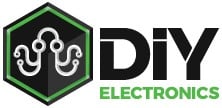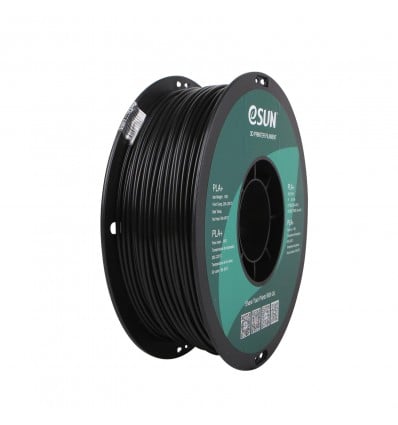International shipping Secure payment
No products
Prices are tax included
Product successfully added to your shopping cart
There are 0 items in your cart. There is 1 item in your cart.
1kg of Black PLA+ eSun Filament spooled and ready for use on 3D Printers with 3mm Hotend Assemblies. Enjoy some of the highest quality filament on the market at very affordable prices. PLA+ filament is high quality, easy to use and bio-degradable. Now with extra additives for increased toughness, greater layer adhesion and less warping.
This product is no longer in stock
Free shipping on orders over R1250 - courier delivery and within South Africa
Please Note: eSun has recently changed their filament spool material. You may receive a cardboard spool, instead of the plastic spools depicted above. This move means a more environmentally friendly design to their 3D filament spools which comfortably sit on your 3D printer's standard spool holder for smooth filament feeding.
PLA+ is a type of eSun filament that is based on standard PLA, but with extra additives to enhance a wide range of qualities. It addresses many of the common problems that PLA Filament presents, such as the brittle nature, low elongation breaking point, as well as layer adhesion. The only area in which regular PLA beats PLA+ is in tensile strength, although it is a slight difference, and is far outweighed by the plethora of benefits.
Advantages of PLA+ Filament
eSun PLA+ Filament is considered by many as the new standard for PLA printing, and despite being slightly more expensive than typical PLA, it offers far more value for money. It is not only easier to work with, but also produces better, smoother and less spider-webbed prints – while also being more flame-resistant as well.
In terms of the value that PLA+ brings to printing, it offers a wide variety of benefits, the first of which you will notice is far greater layer adhesion. This is due to the higher flow temperature, which will also help to produce less spider-webbing in gaps and less stringing along surfaces. Additionally, PLA+ has a lower distortion temperature, which means it is allowed a longer time to settle before it actually cools. This can be particularly beneficial for 3D Printers without enclosures, and helps to ensure that each of the layers are printed before the previous layer starts warping or distorting – further improving on layer adhesion.
While there are many other less predominant benefits, such being less brittle than PLA in filament form, the final key feature we will discuss is PLA+’s print finish quality. Owing to the enhanced layer adhesion, lower Melt Flow Index and higher stable print temperatures, PLA+ produces smoother, cleaner and more durable results. Whereas typical PLA is often brittle and can shatter quite easily, PLA+ has enough elongation and bending strength to resist falls, impacts and breaks from stretching. With these benefits in mind, it’s easy to see why so many Makers are choosing PLA+ as their favourite 3D printer filament.
Additional Note: This eSun Black PLA+ Filament is 3mm in diameter, which is specially used by 3mm Hotend Assemblies with 0.8mm to 1.2mm Nozzles.
eSun Black PLA+ 3mm Filament - Technical Specifications: |
|
|
– eSun |
|
– Polylactic Acid (PLA) |
|
– Specialised Easy-Print Additives |
|
– 2.85mm |
|
– 1.24 |
|
– 52 |
|
– 2(190°C/2.16kg) |
|
– 60 |
|
– 87 |
|
– 3642 |
|
– 29 |
|
– 80 Shore D |
|
– 7 |
|
– 1kg |
eSun Black PLA+ 3mm Filament - Suggested Print Settings: |
|
|
– 190 to 210 |
|
– Brass / Any |
|
– Large: 0.8 to 1.2mm |
|
– No Heat / 50 to 80 |
|
– BuildTak / Magigoo / Painters Tape / PEI |
|
– 25 to 65 |
|
– On from Layer 2+ |
|
– Not Required |
|
– Heating / Sanding / XTC Coating/ Painting |
Helpful Tips for Printing with eSun PLA+ Filament:
In terms of the value that PLA+ brings to printing, it offers a wide variety of benefits, the first of which you will notice is far greater layer adhesion. This is due to the higher flow temperature, which will also help to produce less spider-webbing in gaps and less stringing along surfaces. Additionally, PLA+ has a lower distortion temperature, which means it is allowed a longer time to settle before it actually cools. This can be particularly beneficial for 3D printers without enclosures, and helps to ensure that each of the layers are printed before the previous layer starts cooling, helping to prevent warping or distorting – and further improving on layer adhesion.
With that being said, however, we would still like to offer some great tips to help you get started with PLA+, or to simply help you enhance the results that you’re currently getting, so that you can enjoy the premium print quality of PLA+, with as few hurdles and hoops to jump through as possible. You may notice that these are quite similar to standard PLA, but will be focused towards the extra additives, as these are sometimes what makes PLA+ tricky for those who are just trying it for the first time.
These handy PLA+ 3D Printing Tips are as follows:
- PLA+ Printing Tips – Slightly Different Temperatures: When testing out PLA+ for this first time, you will likely immediately notice that PLA+ utilises a slightly different temperature range, and instead of being the classic 190°C to 220°C of standard PLA, PLA+ requires 205°C to 225°C. However, despite this, we have found that some 3D Printer setups still very capably print PLA+ at 190°C. As such, one of the first tests that you should do when dialling in your new spool of PLA+ is to print a temperature tower, with the Simplify3D Temperature Tower being one of the quickest and least expensive ones to print. This will help you quickly understand which temperatures are best suited for your spool of PLA+, as you will be able to see precisely where the filament is drooping, sagging or producing other forms of heat-related deformities. Bear in mind, however, that if you experience stringing, it may be more related to the next step, flow rate, than temperature, so feel free to ignore the stringing in this step, as it will be remedied later down the line once you have found your ideal temperature. Another thing to consider is that different colours have different pigments, and such each colour of PLA+ may be slightly different, and it’s always a good idea to run through another quick round of tests when getting a new colour, to ensure that your prints are going to look just as good as you want them to.
- PLA+ Printing Tips – Experiment with Flow Rate: In addition to printing at slightly different temperatures than PLA, one of the major differences between these two polymers is that PLA+ has a glass transition temperature that is around 10% lower. This of course means that it also has a lower melting temperature, which in turn means that the flow rate is likely going to be different to what you would use with normal PLA. With this in mind, consider experimenting with the flow rate of PLA+, as well as the bed temperatures too, as these two factors can actually make a huge difference in terms of general print quality, but more so with intricate details on prints. So don’t be scared to increase or decrease the flow rate by between 1% and 3% as you print calibration cubes to dial in your settings, as this will help you get your foundational settings right before moving onto more complex fine-tuning.
- PLA+ Printing Tips – PLA Plus is Not True PLA: As a final note, although this point doesn’t necessarily pertain to printing parameters, it’s important to remember that PLA+ is not true PLA. This is important because a lot of Makers like to use PLA for prints like cookie cutters and other parts that briefly come into contact with food or food-related items. And while we typically don’t recommend having 3D Prints come into contact with any types of foods, we feel that this is even more important for PLA+, since the additives within this polymer are relatively unknown, and when it comes to health, it’s better to be safe than sorry. Additionally, to build further on this point, if you love to post-process prints to make them look even better, you may need to do some experimentation with the smoothening, colouring and priming agents that you use.
Additional Resources for 3D Printing PLA+:
Before diving headfirst into this section, it’s important to remember that PLA+ is very similar to standard PLA, but has just been modified slightly to make it easier to print with and slightly more durable. With this in mind, you will notice that a lot of the following resources are catered toward standard PLA, but should work almost exactly the same for PLA+ Filament too. So, without further ado, the following are some of the top extra resources that we’ve found for 3D Printing PLA+, which may offer some great tips and assistance for even the most advanced of 3D Makers:
- This is a relatively general Guide on PLA Printing by Simplify3D, world-renowned experts in 3D modelling and Computer Aided Design. It offers so great tips for troubleshooting minor problems, while giving some good general guidelines on how to “dial in” your 3D Printer one step at a time.
- The next awesome resource we have to share is the Awesome Rigid Ink PLA Guide, which offers a mountain-load of insights into the chemical and material composition of PLA, with a slew of great tips and tricks on how to get your PLA looking good (and behaving properly) for every print.
- Finally, this is just a great General 3D Printing Quality Guide, that is designed to help users troubleshoot various quality-related problems, while giving some great tips on what to do when certain problems arise. If you’re struggling with an issue, this is a great place to find out what is actually going wrong, as well as how you can remedy it, with good explanations of why certain remedies work to fix certain problems.
| Colour | Black |
| Special | Normal |
| Plastic Type | PLA |
| Plastic Diameter | 3mm |
| Plastic Weight | 1kg |
No customer reviews for the moment.
Shenzhen eSUN Industrial Co., Ltd was established in 2002 in Shenzhen Special Economic Zone and has rapidly become one of the leading international suppliers of 3D Printing Filament. They specialise in research, development and production of degradable polymer materials, and have grown their catalogue of filaments to include PLA, ABS, PC, PVA, and a wide range of other polymers and copolymers.
Their list of exclusive filament formulas include unique materials like wood, aluminium, bronze and other materials to create highly specialised filaments that can stretch, bend, be moulded or otherwise behave in very unique ways. Their filaments are also commonly characterised by their absolutely round shape, extremely low diameter tolerance, uniform colours and impressively stable melting points. These characteristics, in combination with their long-term insistent policy of “Best Quality, Reasonable Price” has garnered them a large share of the market, with their reputation commonly preceding them within knowledgeable online and offline 3D Printing communities.
eSUN’s popularity in the industry has also helped to produce sustainable partnerships with many internationally famous 3D Printer manufacturers and distributors, with DIYElectronics having sole distributorship rights to provide their 3D Printing Filaments to South Africa and neighbouring African countries.







